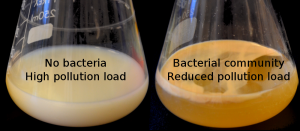Whether two bacterial species cooperate or compete can depend on environmental conditions. The Stress Gradient Hypothesis (SGH) states that one factor that can mediate this switch is how stressful the environment is, and although there is increasing evidence supporting this idea, it is unclear why this would be the case.
In a first study, we showed that toxicity can drive facilitation between four species growing in industrial pollutants called Metal Working Fluids (MWF) [1]. In this toxic environment, the presence of other species enhanced survival, allowing them to degrade the pollutant efficiently. Adding in additional nutrients switched interactions to competition between any two species that were able to grow alone.
To find a more mechanistic explanation for the SGH, a second study involving only two of these four species showed that increasing the concentration of a single compound could drive the switch from competition to facilitation [2]. Mechanistically, we discovered that high concentrations of this compound were toxic due to the spontaneous accumulation of Reactive Oxygen Species (ROS), and adding an antioxidant removed toxicity and reverted the interaction back to competition. Our results support the SGH and show mechanistically how competition and facilitation can occur simultaneously, and can be balanced by environmental conditions. Because compound toxicity is often concentration-dependent, we expect this phenomenon be widespread and shape bacterial interaction networks in other ecosystems.
Based on these findings, we have developed a mathematical framework that can help predict how interactions are expected to change over time, as microbes grow in and thereby modify their environment [3]. This framework is based on consumer-resource models, a common type of ecological model in which interactions between species are modulated by the environment, and allows one to map it onto generalised Lotka Volterra models, which are popular in representing direct interactions between species. By bridging these two model types, our framework can help predict dynamics in changing environments, like batch cultures or spatially organised environments [3, 4].
References
1. P. Piccardi, B. Vessman, S. Mitri (2019) PNAS.
2. R. Di Martino*, A. Picot*, S. Mitri (2024) PLoS Biology.
3. O. Meacock, S. Mitri (2023) bioRxiv.
4. A. Picot, S. Shibasaki, O. J. Meacock, S. Mitri (2023) Curr Opin Microbiol.

